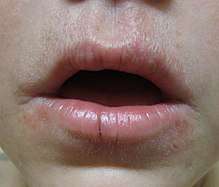Lip licker's dermatitis
| Lip licker's dermatitis | |
|---|---|
| Synonyms | Perioral dermatitis |
 | |
| Lip lickers dermatitis from a child repeatedly licking lips | |
| Causes | Repeated lip licking |
| Diagnostic method | Based on symptoms |
| Differential diagnosis | Periorificial dermatitis |
| Medication | Emollient |
Lip licker's dermatitis, popularly known as perioral dermatitis, is an Irritant contact dermatitis on and around the lips due to saliva from repetitive lip licking.[1] Involving children more than adults, the resulting papules, scaling, erythema and occasional fissures and crusting make a well-defined ring around the lips. The rash extends as far as the tongue can reach and frequently spares the angle of the mouth. Unlike periorificial dermatitis, the vermillion border of the lip is often involved and the treatment is simple moisturisers.[2]
Signs and symptoms

Redness around the lips in circumoral distribution with dryness and scale is typical.[3] Chapping may also occur, especially in cold weather.[4]
Causes
Repeated licking resulting in a cycle of wetting and drying causes the redness, fissuring and scale.[2] IIt can also occur with lip chewing, thumb sucking or excessive drooling.[5]
Wind instrument players may also experience lip licker's dermatitis.[6]
Compulsive licking of lips causing lick lip dermatitis is also seen as psychological disorder.[7]
Persistent and continuous breathing from the mouth can cause dry lips and result in temptation to repeated lick lips.[8]
Diagnosis
The diagnosis of lip licker's dermatitis is from the history and inspection of the rash. It is important to distinguish it from allergic contact dermatitis and perioral dermatitis which are characterised by papules in the perioral area and sparing of the vermillion border, and worsened by topical steroids.[3]
Treatment
Generous application of bland emollients can improve the rash. However, complete resolution will not occur until the lip licking stops.[2] Breaking the cycle of dryness then licking followed by more dryness is key to treatment. Sometimes, unlike in perioral dermatitis, topical steroids may be used for few days only.[9]
References
- ↑ "ICD-11 Beta Draft - Mortality and Morbidity Statistics". icd.who.int. Retrieved 2017-11-14.
- 1 2 3 Cohen, Bernard C (2013). Paediatric Dermatology. Elsevier. pp. 240–263. ISBN 978-1-4557-3795-6.
- 1 2 Paller, Amy S.; Mancini, Anthony J. (2015-10-20). Hurwitz Clinical Pediatric Dermatology: A Textbook of Skin Disorders of Childhood and Adolescence. Elsevier Health Sciences. ISBN 9780323244756.
- ↑ Rudikoff, Donald; Cohen, Steven R.; Scheinfeld, Noah (2014-03-06). Atopic Dermatitis and Eczematous Disorders. CRC Press. ISBN 9781840761955.
- ↑ Leung, Donald; Szefler, Stanley; Bonilla, Francisca; Akdis, Cezmi A; Sampson, Hugh (2016). Paediatric Allergy (third ed.). pp. 467–481. ISBN 978-0-323-29875-9.
- ↑ Bolognia, Jean L; Schaffer, Julie V; Cerroni, Lorenzo (2018). Dermatology (4th ed.). Elsevier. pp. 1569–1594. ISBN 978-0-7020-6275-9.
- ↑ Harth, Wolfgang; Gieler, Uwe; Kusnir, Daniel; Tausk, Francisco A. (2008-11-14). Clinical Management in Psychodermatology. Springer Science & Business Media. ISBN 9783540347187.
- ↑ Kliegman, Robert M; Bonita F. Stanton, Bonito; St Geme, Joseph; Schor, Nina F (2016). Nelson Textbook of Paediatrics. Elsevier. pp. 1078–1082. ISBN 978-0-323-44919-9.
- ↑ Braun-Falco, Otto; Plewig, Gerd; Wolff, Helmut Heinrich; Burgdorf, Walter (2000-09-27). Dermatology. Springer Science & Business Media. ISBN 9783540594529.